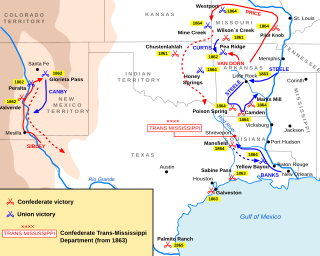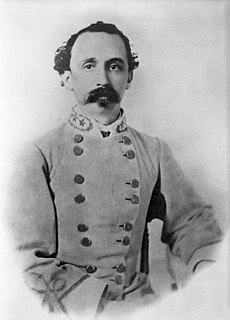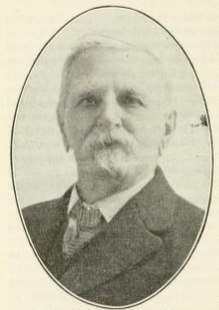
The Battle of Pea Ridge, also known as the Battle of Elkhorn Tavern, took place in the American Civil War near Leetown, northeast of Fayetteville, Arkansas. Federal forces, led by Brig. Gen. Samuel R. Curtis, moved south from central Missouri, driving Confederate forces into northwestern Arkansas.

William Nelson Rector Beall was a brigadier general in the Confederate States Army during the American Civil War. He is most noted for his supply efforts on behalf of Confederate prisoners of war.

Santos Benavides was a Confederate colonel during the American Civil War. Benavides was the highest-ranking Tejano soldier in the Confederate military.

Benjamin McCulloch was a soldier in the Texas Revolution, a Texas Ranger, a major general in the Texas militia and thereafter a major in the United States Army during the Mexican–American War, sheriff of Sacramento County, a U.S. marshal, and a brigadier general in the army of the Confederate States during the American Civil War.

Major-General Sterling Price was a senior officer of the Confederate States Army who fought in both the Western and Trans-Mississippi theaters of the American Civil War. He rose to prominence during the Mexican–American War and served as governor of Missouri from 1853 to 1857. He is remembered today for his service in Arkansas (1862–1865) and for his defeat at the Battle of Westport on October 23, 1864.

Henry Eustace McCulloch was a soldier in the Texas Revolution, a Texas Ranger, and a brigadier general in the army of the Confederate States during the American Civil War.

Matthew Duncan Ector was an American legislator, a Texas jurist, and a general in the Confederate States Army during the American Civil War.

Gordon Granger was a career U.S. Army officer and a Union general during the American Civil War, where he distinguished himself at the Battle of Chickamauga.

Earl Van Dorn was a United States Army officer and great-nephew of Andrew Jackson, fighting with distinction during the Mexican–American War, against several tribes of Native Americans, and in the Western theater of the American Civil War as a Confederate major general.

The Cortina Troubles is the generic name for the First Cortina War, from 1859 to 1860, and the Second Cortina War, in 1861, in which paramilitary forces, led by the Mexican rancher and local leader Juan Nepomuceno Cortina, confronted elements of the United States Army, the Confederate States Army, the Texas Rangers, and the local militias of Brownsville, Texas, and Matamoros, Tamaulipas.

John Salmon Ford, better known as "Rip" Ford, was a member of the Republic of Texas Congress and later of the State Senate, and mayor of Brownsville, Texas. He was also a Texas Ranger, a Confederate colonel, doctor, lawyer, and a journalist and newspaper owner. Ford commanded men during the Antelope Hills Expedition and he later commanded the Confederate forces in what was arguably the last engagement of the American Civil War, the Battle of Palmito Ranch on May 12–13, 1865. It was a Confederate victory, but as it occurred more than a month after Robert E. Lee's surrender it had no effect on the outcome of the war.

The Army of the West, also known as the Trans-Mississippi District, was a formation of the Confederate States Army during the American Civil War that was a part of the Army of Mississippi. It saw action in the Battle of Pea Ridge, Battle of Corinth, and Battle of Iuka and consisted of about 20,000 personnel.

The Trans-Mississippi Theater of the American Civil War consists of the major military operations west of the Mississippi River. The area is often thought of as excluding the states and territories bordering the Pacific Ocean, which formed the Pacific Coast Theater of the American Civil War (1861–1865).

William Steele was a career United States Army officer who served with distinction during the Mexican–American War. He later served as a Confederate general during the American Civil War.
The 1st Arkansas Cavalry Battalion (Stirman's) (1864-1865) was a Confederate Army cavalry battalion during the American Civil War. The unit was also known as Brooks 1st Arkansas Cavalry Battalion, Stirman's, 1st Arkansas Cavalry Battalion, Stirman's Sharpshooter Regiment, 1st Regiment Arkansas Sharpshooters, and finally simply as Stirman's Arkansas Cavalry Regiment.
Charles Wesley Phifer was a Confederate States Army officer during the American Civil War who was unofficially appointed brigadier general.

The 3rd Texas Cavalry Regiment or South Kansas-Texas Mounted Volunteers was a unit of mounted volunteers that fought in the Confederate States Army during the American Civil War. The regiment fought at Wilson's Creek and Chustenahlah in 1861, Pea Ridge, Corinth siege, Iuka, Second Corinth, and the Holly Springs Raid in 1862, Thompson's Station in 1863, and at Yazoo City, in the Atlanta campaign, and at Nashville in 1864. The regiment surrendered to Federal forces in May 1865 and its remaining 207 men were paroled.

The 27th Texas Cavalry Regiment, at times also known as Whitfield's Legion or 1st Texas Legion or 4th Texas Cavalry Battalion, was a unit of mounted volunteers that fought in the Confederate States Army during the American Civil War. First organized as the 4th Texas Cavalry Battalion or the 1st Texas Legion, the unit fought at Pea Ridge, First Corinth, Iuka, and Second Corinth. Additional companies from Texas were added and the unit was upgraded to a regiment in late 1862. The 27th Texas Cavalry fought at Holly Springs in 1862, Thompson's Station in 1863, and in the Atlanta campaign, Franklin, and Nashville in 1864. The regiment surrendered to Federal forces in May 1865 and its remaining soldiers were paroled.

The 6th Texas Cavalry Regiment was a unit of mounted volunteers that fought in the Confederate States Army during the American Civil War. The regiment fought at Chustenahlah in 1861. The following year the unit fought at Pea Ridge, First Corinth, Second Corinth, Hatchie's Bridge, and Holly Springs. The 6th Texas Cavalry participated in the fighting at Thompson's Station in 1863, the Atlanta campaign, and the Franklin–Nashville Campaign in 1864. The regiment formally surrendered to Union forces in May 1865 and its remaining soldiers were paroled.
Thomas Grimke Rhett was a graduate of the United States Military Academy at West Point, New York and a United States Army officer who served from July 1, 1845 to April 1, 1861. He served in the Mexican-American War in 1847–1848. Rhett was awarded a brevet appointment as captain for gallantry in the defense of Puebla, Mexico during the Siege of Puebla, October 12, 1847. After his resignation from the U.S. Army, April 1, 1861, he was appointed a brigadier general in the South Carolina Militia but did not serve in that office. He was a staff officer in the Confederate States Army in the Eastern Theater of the American Civil War from April 1861 until May 31, 1862. He first served as voluntary aide-de-camp to General Pierre G. T. Beauregard and then major from April to July, 1861. Rhett then served as chief of staff to Beauregard's successor, General Joseph E. Johnston. After Johnston was wounded on May 31, 1862 and was succeeded in command by General Robert E. Lee, Rhett was transferred to the District of Arkansas in Confederacy's Trans-Mississippi Department where he served as chief of ordnance. From April 1863 until the end of the war in 1865, he served as chief of artillery in the Trans-Mississippi Department. From 1865 to 1873, he served as a colonel of ordnance in the Egyptian Army.


















